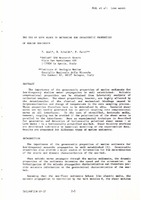| dc.contributor.author | Akal, Tuncay | |
| dc.contributor.author | Schmidt, Henrik | |
| dc.contributor.author | Curzi, P. | |
| dc.date.accessioned | 2018-10-11T14:05:27Z | |
| dc.date.available | 2018-10-11T14:05:27Z | |
| dc.date.issued | 1986/06 | |
| dc.identifier | 672 | |
| dc.identifier.govdoc | CP-37 | |
| dc.identifier.uri | http://hdl.handle.net/20.500.12489/109 | |
| dc.description.abstract | The importance of the geoacoustic properties of marine sediments for low-frequency shallow water propagation is well established. Reliable compressional properties can be obtained from laboratory analysis of collected samples. The shear properties, however, are highly affected by the deterioration of the chemical and mechanical bindings caused by de-pressurization and change of temperature in the core sampling process. These properties therefore have to be determined in situ. Isolated shear waves are not easily generated due to partial coupling into compressional waves at all interfaces. In the case of stratified, isotropic media, however, coupling can be avoided if the polarization of the shear waves is parallel to the interfaces. Here an experimental technique is described for generation and detection of horizontally polarized shear waves - or Love waves - in a horizontally stratified sea-bed. Shear velocity profiles are determined indirectly by numerical modelling of the experimental data. Results are presented for different types of marine sediments. | |
| dc.format | 14 p. : ill. ; digital, PDF file | |
| dc.language | English | |
| dc.publisher | NATO. SACLANTCEN | |
| dc.source | In: Selected papers on ocean-seismo acoustics low-frequency underwater acoustics (SACLANTCEN Conference Proceedings CP-37), 1986, pp. 2-0 - 2-12. | |
| dc.subject | Shear waves | |
| dc.subject | Seafloor sediments | |
| dc.subject | Geoacoustics | |
| dc.title | The use of Love waves to determine the geoacoustic properties of marine sediments | |
| dc.type | Papers and Articles | |
| dc.type | Conference Proceedings (CP) | |
